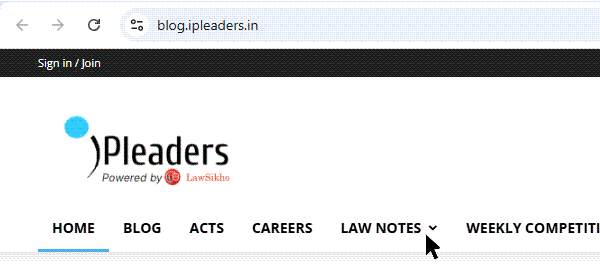This article is written by Ritesh Kumar and further updated by Syed Owais Khadri. The article discusses malicious prosecution under the law of torts. It attempts to understand the meaning, essential elements, and legal provisions relating to the concept and also looks into a few cases.
This article has been published by Anshi Mudgal.
Table of Contents
Introduction
The usage and misuse of any law are like two sides of the same coin. Although the legislators try their best not to leave any scope for misuse of any law, there are often minute loopholes that are exploited. One such example of misuse of the law that is employed to harm someone is malicious prosecution.
Malicious prosecution happens when someone starts legal proceedings, often criminal, against someone else with bad intentions instead of valid reasons. If you’ve been wrongly targeted by such baseless actions, the law offers you protection through civil remedies. You can seek compensation from the person who initiated the malicious case. It’s a way to ensure justice and make up for the trouble caused by unfounded legal accusations.
In this article, we are going to discuss the meaning, essentials, case laws and other aspects relating to malicious prosecution as a civil wrong.
Meaning of malicious prosecution
Before indulging in a discussion relating to malicious prosecution as a tort, we must understand the meaning of the term.
Black’s Law Dictionary defines malicious prosecution as “a legal proceeding that is initiated without probable cause and with harmful intent.” In simpler terms, malicious prosecution is when someone files a case just to cause trouble or harm to another person, rather than pursuing justice.
In the case of West Bengal State Electricity Board vs. Dilip Kumar Ray (2006), the Supreme Court discussed the concept and explained what malicious prosecution means. It is when someone starts a legal case against another person, not because they have a valid reason, but with a dishonest or unfair motive. In other words, it is using the legal system to harm or trouble someone, even though there’s no good reason to justify the case.
In simple words, malicious prosecution can be defined as starting any criminal legal/judicial proceeding against any individual with ill or evil intentions and without any just reason or cause for such a proceeding.
The difference between abuse of power and malicious prosecution
There are other aspects relating to misuse of legal procedure, power, etc, which sound somewhat similar to malicious prosecution. As the meaning of malicious prosecution has been discussed, it is also significant to understand the differences between each of the kinds of misuse of legal procedures and powers. Let us look into the differences between abuse of power, process and malicious prosecution.
Malicious prosecution is one of the kinds of methods of abuse of legal proceedings. However, abuse of power and malicious prosecution are different things. Likewise, abuse of process and malicious prosecution are also different concepts.
It is important to understand the differences between these legal concepts so we can choose the right remedy for the situation. Even though some of these concepts might seem similar at first glance, they each have unique meanings and applications. Let’s take a closer look in the next section to break down these differences and make them easier to understand.
Malicious prosecution and abuse of process
Abuse of process and malicious prosecution are concepts that fall under the heading of misuse of legal procedures or processes. Both concepts mostly look similar, but there is a slight difference between the two. Rather, malicious prosecution can be considered as a part of abuse of existing legal processes or procedures. The main difference between the nature and timing of misuse of legal process and the intention of the person misusing it. In case of malicious prosecution, misuse takes place at the very beginning with the start of a criminal judicial proceeding without any justified reason or cause. On the other hand, abuse of process means the misuse of legal procedures to gain unfair or illegitimate goals.
For example,
Imagine person X accuses person Y of theft, and as a result, criminal proceedings are initiated against Y. If Y is found not guilty or acquitted, he has the right to file a claim for malicious prosecution against X. However, for Y to succeed in their claim, they need to prove a few things. It is not enough for Y to simply be acquitted, he should be able to show that the proceedings were initiated unfairly and maliciously. Plus, Y must fulfil other essentials, which we will discuss in detail later in this article, for his claim to be successful and for them to be awarded any damages.
On the other hand, abuse of process misuse of a lawful process to attain a wrongful end. It is the use of a legal proceeding or any legal procedure to attain a goal that may be unlawful. For example, filing a false case against an individual to pressurise such an individual to do something as per the wishes of the person filing the case. Or the presentation of fake witnesses to win a legal proceeding.
The difference between abuse of process and malicious prosecution was also emphasised in the case of West Bengal State Electricity Board vs. Dilip Kumar Ray (2006). The Supreme Court in this case said that the difference between the two is that malicious prosecution means wrongfully starting a judicial proceeding (issuing of process maliciously), and abuse of process is the usage of legal procedures for any purpose other than the original purpose of such process as intended by the law. Simply put, abuse of process is the improper use of a judicial proceeding started normally.
The difference between abuse of process and malicious prosecution is clear. Let us now move on to differentiate malicious prosecution from abuse of power.
Malicious prosecution and abuse of power
Abuse of power and abuse of process are similar but not the same. Abuse of process happens when someone misuses the legal system, like starting a malicious prosecution. On the other hand, abuse of power is when someone misuses the authority or power they have in their role, but it does not have to do with the legal system. So, abuse of process is about misusing the courts and abuse of power is about misusing official power or authority.
Let’s say A is a police officer, and B is a vegetable vendor. If A threatens B with arrest and arrests him just because B refuses to give A a bribe, that’s an abuse of power. A is misusing his authority to punish someone for not complying with a personal demand.
On the other hand, if A were to file a false criminal case against B and start a legal proceeding, claiming B committed a crime just because B did not give A the bribe, that would be malicious prosecution. In this case, A is misusing the legal system to harm B, even though there is no real cause for the charge.
The main difference between the two is that malicious prosecution is limited to one particular act or a proceeding, while abuse of power includes wider scope and various acts of misconduct or unlawful use of lawful authority.
Now that we’ve discussed the meaning of the concept and the differences with the other concepts that are similar to malicious prosecution, let us now completely stick to the concept of malicious prosecution. Let us begin with the essential elements to seek remedy in cases of malicious prosecution.
Essential elements of malicious prosecution
If someone has been wrongly taken to court through malicious prosecution, they can seek damages from the person who filed the case. However, to get those damages, they need to prove that the prosecution was done with bad intentions and without a solid reason. The person has to show certain essential points in court, with the main one being that the legal action was malicious and lacked any reasonable basis.
The following are the essential elements that the plaintiff is required to prove in a suit for damages for malicious prosecution.
- Prosecution by the defendant.
- Absence of reasonable and probable cause.
- The defendant acted maliciously.
- Termination of proceedings in favour of the plaintiff.
- The plaintiff suffered damage as a result of the prosecution.
The essential elements to claim damages or compensation in a suit for malicious prosecution have also been explained by the Hon’ble High Court of Guwahati in the case of Manik Das vs. Dilip Biswas (2013) [A.I.R. 2013 Gau. 1]. The Court in this case stated the essentials to be fulfilled in a suit for malicious prosecution as follows.
- To claim damages for malicious prosecution, the plaintiff needs to show that they were wrongly accused and taken to court by the defendant, but the case against them didn’t succeed. In other words, the plaintiff must prove that they were found not guilty or acquitted in the end.
- The plaintiff should show that there was no valid or reasonable reason for the criminal case against them. In other words, the plaintiff should prove that the prosecution was without any valid cause, and the legal action was unjustified from the start.
- The plaintiff should show that the criminal case was started with bad intentions, meaning the person who filed it had a malicious purpose. The plaintiff also needs to prove that the proceedings caused harm or damage to them, whether it’s emotional distress, damage to reputation, or any other negative impact.
Therefore, let us understand the five essentials to be established while claiming damages for malicious prosecution one by one. The essentials have been discussed as follows.
Prosecution by the defendant
The first essential element that the plaintiff is required to prove in a suit for damages for malicious prosecution is that he (the plaintiff) was prosecuted by the defendant. The word “prosecution” carries a wider sense than a trial and includes criminal proceedings by way of appeal, or revision.
In the case of Musa Yakum vs. Manilal (1904) [7 Bom. L.R. 20], the Hon’ble High Court of Bombay clarified an important point regarding malicious prosecution. The court ruled that just because a court ordered the prosecution, it doesn’t automatically justify the prosecution, especially if the decision was influenced by false evidence provided by the defendant.
In the case of Khagendra Nath vs. Jacob Chandra (1976) [1976 Assam L.R. 379], the Assam High Court explained that just bringing a case to an executive authority doesn’t count as prosecution. So, if you simply present an issue to a government official or authority, it doesn’t automatically mean that malicious prosecution has happened. The court made it clear that in such cases, you can’t file a claim for malicious prosecution.
It is important to remember that the concept of malicious prosecution is not just limited to judicial proceedings in courts. The term “prosecution” is wide and can also apply to actions by other authorities like the police, tribunals, quasi-judicial bodies, or even departmental boards. So, it is necessary to know whether bringing a case before these authorities, without a valid reason and with bad intentions, can be considered malicious prosecution as well.
Let us understand and find out the answer to the said question. Let us begin with understanding if prosecution by a police officer can be considered as malicious prosecution.
Prosecution by a police officer
The question of whether a proceeding before a police officer can be regarded as malicious prosecution has been discussed in a few judicial decisions wherein the courts have ruled the question in the negative. For example, the Calcutta High Court, in the case of Nagendra Nath Ray vs. Basanta Das Bairagya (1929) [I.L.R. (1929) 47 Cal. 25], observed that mere proceedings before a police officer cannot be considered as prosecution.
Prosecution before quasi-judicial authority
The function rendered by quasi-judicial authorities is also similar to that of the courts since they include judicial proceedings and the pronouncement of a decision. However, there is no law to prescribe whether a prosecution before a quasi-judicial authority amounts to malicious prosecution or not. The issue has been discussed in various cases from time to time, and the judiciary has attempted to lay down clarity around the same.
The Hon’ble High Court of Punjab and Haryana in the case of Kapoor Chand Rikhi Ram Mahajan vs. Hakim Jagdish Chand Siripat Rai And Anr (1973) held that malicious prosecution before the Board of Ayurvedic and Unani system of medicines made the respondent entitled to compensation.
In another case, D.N. Bandopadhyaya vs. Union of India (Uoi) and Ors. (1975), the Hon’ble High Court of Rajasthan held that a departmental enquiry by a disciplinary committee cannot be considered as prosecution. The court had held that an authority discharging quasi-judicial function could not be regarded as a judicial authority and hence it cannot be called a prosecution.
However, the former decision appears to be more logical than the latter since the proceedings before quasi-judicial authority are similar to a few judicial functions and baseless proceedings with malicious intent before any such authority may impose equal harm as it may do in case of prosecution before a judicial authority.
Absence of reasonable and probable cause
One of the most important things to prove in a malicious prosecution case is that there was no valid or reasonable reason for the prosecution to happen in the first place. So, if someone is seeking compensation for malicious prosecution, they need to show that the person who brought the case against them had no real grounds to do so. The court will look at all the facts to decide whether there was a valid reason for the prosecution or if it was done without any cause.
The necessity to prove that there was no valid or reasonable cause for the prosecution has been highlighted in several judgments. In the case of Antarajami Sharma vs. Padma Bewa and Ors. (2007), the Orissa High Court made it clear that it was up to the plaintiff to prove that the prosecution was baseless and lacked any justified reason. In simple terms, the person claiming malicious prosecution should show that there was no legitimate cause behind the case.
Furthermore, if a man prefers an indictment containing several charges, wherein for some there is, and for others there is no probable cause, he is still guilty of malicious prosecution.
The defendant acted maliciously.
In a suit for damages for malicious prosecution, another essential element that the plaintiff is required to prove is that the defendant acted maliciously in prosecuting him and not with a mere intention of carrying the law into effect. Malice need not be a feeling of enmity, spite, ill will or spirit of vengeance, but it can be any improper purpose that motivates the prosecutor, such as to gain a private collateral advantage.
The Hon’ble Supreme Court, in the case of Bank of India vs. Lakshmi Das (2000), reiterated the position concerning a proceeding claiming damages for malicious prosecution. The Court reiterated that the absence of a probable and reasonable cause is obligatory to be proved. The proceedings complained of by the plaintiff must be initiated in a malicious spirit that is from an indirect and improper motive and not in furtherance of justice. If the defendant fails to prove the absence of honest confidence in the accusation and hence the presence of reasonable and probable cause while instituting the proceeding in question, then malicious intent can be assumed on the defendant’s part.
It is not necessary for the defendant to be acting maliciously right from the moment the prosecution was launched. If the prosecutor is innocent in the beginning but becomes malicious subsequently, an action for malicious prosecution can still lie. The continuation of proceedings by the defendants even after becoming aware of the innocence of the plaintiff at any stage of the proceedings amounts to malicious prosecution.
Termination of proceedings in favour of the plaintiff
In a suit for damages for malicious prosecution, it is essential to show that the proceedings which are in question as malicious were terminated in favour of the plaintiff. Termination in favour of the plaintiff does not mean judicial determination of his innocence but the absence of judicial determination of his guilt. Malice need not be a feeling of enmity, spite, ill will or spirit of vengeance, but it can be any improper purpose that motivates the prosecutor, such as to gain a private collateral advantage. In simple words, the acquittal of the plaintiff by the court in the proceedings in question is essential to prove malicious prosecution.
From this essential of acquittal, one of the important points that can be inferred is that no action for malicious prosecution can be brought when the trial is still pending. It is one of the aspects of the rule of law that no individual should be allowed to accuse a pending suit/trial as unjust.
The plaintiff suffered damage as a result of the prosecution
The last and one of the most important elements of malicious prosecution is that the plaintiff should show some harm caused because of the prosecution. In simpler terms, the person claiming malicious prosecution needs to prove that the defendant’s actions caused damages. These damages can fall into three main categories, which are explained below.
- Damage to reputation
- Damage to a person
- Property damage.
Burden of proof
The burden of proof in the cases of malicious prosecution lies upon the plaintiff (i.e., the aggrieved party against whom malicious proceedings have been instituted) to establish all five essentials of malicious prosecution and hence to prove that the legal proceedings against him were initiated without any reasonable cause and with malicious intent.
Malicious civil proceedings
The court, in the case of Darbhangi Thakur vs. Mahabir Prasad (1917), held that no action can be instituted against any person in case of civil proceedings, unlike in cases of criminal proceedings, even though the essentials of malicious intent and absence of reasonable or probable cause are established.
This position was, however later reversed in the case of Genu Ganapati vs. Bhalchand Jivraj and Anr. (1981), wherein the court held that malicious abuse of civil proceedings can be established if the following essentials are satisfied.
- Ill/bad intentions should be proved.
- The plaintiff must show and prove two main points. First, that the defendant acted without any reasonable or justified cause, and second, that the legal proceedings against the plaintiff have either ended in their favour or have been dismissed or dropped altogether.
- The plaintiff should also show that the civil proceedings disturbed his freedom or property, or negatively impacted or can harm their reputation.
Remedies against malicious prosecution
Malicious prosecution may cause irreparable damage to an individual’s reputation and life in general. That’s why it’s crucial to have remedies available for those who are wrongfully targeted. The following two are the remedies that could be availed against malicious prosecution.
- A suit for damages under Section 35 can be filed by the aggrieved party claiming compensation for damage to reputation or malicious prosecution in civil proceedings. Legal costs may also be recovered.
- A writ can be filed under Article 32 or Article 226 of the Constitution claiming relief against any malicious criminal proceedings.
Defences against a claim of malicious prosecution
The individuals being accused of malicious prosecution also have certain defences that can be employed against accusations of them initiating a legal proceeding with malicious intent. One of the most common defences to claim malicious prosecution is to establish that the prosecution wasn’t done with malice or without any reasonable grounds.
Presence of reasonable grounds
One of the most common and valid defences in the cases of malicious prosecution is that the prosecution was not on unreasonable or unjustified grounds. The defendant can claim the defence of the presence of valid and reasonable grounds for starting a prosecution against the plaintiff. The defendant should prove that the prosecution of the plaintiff was because of the belief that there were justified reasons for starting such prosecution.
Presence of good faith
Another way the defendant can defend against a malicious prosecution claim is by proving that he acted in good faith. This means the defendant should show that he did not have bad intentions when he started the legal proceedings. He should prove that he had valid reasons for the case and that it was not about causing harm to the plaintiff or falsely accusing him. The defendant should show that he was not trying to misuse the legal system maliciously.
Legal provisions relating to malicious prosecution under the law of tort
Since malicious prosecution is generally discussed and dealt with as a concept of tort, there is no legal provision that expressly penalises it. Two provisions of the Civil Procedure Code, 1908, namely Section 19 and Section 35, can be invoked to claim relief against malicious proceedings. Similarly, the tort of defamation may also be invoked to claim relief in the cases of malicious prosecution since it involves the communication of false information about an individual to another individual.
Section 19 of the Civil Procedure Code, 1908 allows a person to file a suit for compensation if he/she has suffered harm due to a wrongful act done to him/her or his/her movable property. So, if someone feels he/she has been wronged, whether personally or to their property, then he/she can take legal action to claim damages or compensation under this section.
Section 35 of the Civil Procedure Code, 1908 addresses the costs of litigation. If someone is maliciously prosecuted, the person who is wrongfully accused (the defendant in the malicious prosecution case) can recover the costs of defending themselves. This includes not only the costs involved in fighting the prosecution but also any costs incurred in claiming damages for the malicious prosecution. In simple terms, if someone initiates legal proceedings with malice, they can be asked to pay for the costs of defending against those proceedings.
The importance of legal provisions regarding any concept is clearly understood by the interpretation or application of those provisions in real-life instances or cases, which is done by the judiciary. As we’ve looked into the legal provisions that can be used in cases of malicious prosecution, let us now go ahead and discuss a few important case laws/judicial decisions relating to the concept of malicious prosecution.
Case laws relating to malicious prosecution under the law of tort
The role of the judiciary becomes immensely important and relevant in cases relating to malicious prosecution since there is no express framework laid down about the concept. Some of the significant judicial decisions relating to malicious prosecution are discussed as follows.
West Bengal State Electricity Board vs. Dilip Kumar Ray (2006)
In the case of West Bengal State Electricity Board vs. Dilip Kumar Ray (2006), the Supreme Court made some important points about what malicious prosecution means. This case is important because the court gave a detailed explanation of the definition of malicious prosecution and related issues. It was an appeal against a decision made by the Calcutta High Court, and the Supreme Court’s judgment helped clarify how cases of malicious prosecution should be understood and dealt with in the legal system..
Let us look into the brief facts, issues and judgment of the case below.
Facts
- The case started when disciplinary proceedings were launched against the defendant. After this, an FIR was registered against him, and interestingly, the FIR was based on the same reasons that led to the disciplinary action in the first place.
- The Trial Court found that the allegations against the defendant were completely baseless. Because of this, the court ordered the appellant to pay Rs. 1 lakh in compensation to the defendant. The amount was split into two parts, i.e., Rs. 50,000 for the harm done to the defendant’s reputation and Rs. 50,000 for the harassment they went through due to the false prosecution.
- The High Court agreed with the Trial Court’s decision but decided to reduce the compensation amount to Rs. 50,000. The appellant then took the case to the Supreme Court, challenging the High Court’s decision.
Issues
- Whether the defendant entitled to compensation from the appellant for malicious prosecution?
Judgement
The Supreme Court overturned the High Court’s decision. The Court felt that the High Court did not fully understand the case and its facts. It pointed out that there was confusion in how the High Court viewed the case. Because of this, the Supreme Court found the conclusions made by the High Court to be contradictory and not relevant to the matter at hand.
The Apex Court noted various definitions and interpretations of the term “malicious prosecution”. It noted the following two elements as the essentials of malicious prosecution.
- Lack of probable cause for the institution of prosecution.
- The prosecution in question must have ended in the defendant’s favour.
The Supreme Court also pointed out the difference between malicious prosecution and abuse of process, which we discussed earlier under the heading of “malicious prosecution and abuse of process.”
Bolandanda Pemmayya and Anr. vs. Ayaradara Kushalappa (1965)
In the case of Bolandanda Pemmayya and Anr. vs. Ayaradara Kushalappa (1965), the appellants filed an appeal before the Hon’ble Karnataka High Court, challenging a district judge’s order. The district judge had directed the appellants to pay compensation to the respondent for malicious prosecution. The court in this case dealt with the question of whether a proceeding before any police authority would qualify as prosecution.
Let us briefly look at the facts, issues and judgment of the case
Facts
The case began when the appellant went to the police station and filed a complaint against the respondent, accusing him of theft. The police, after looking into the matter thoroughly, found that the allegations were completely false. They dismissed the complaint, saying there was no truth to the theft accusation.
After the police cleared the respondent of the theft accusation, the respondent decided to take legal action and filed a suit for damages, claiming malicious prosecution. Initially, the Munsiff Court dismissed the suit, but the respondent didn’t give up. The case was then taken to the District Judge, who ruled in favour of the respondent and awarded him Rs. 200 as compensation for the malicious prosecution caused by the appellant.
This decision was appealed before the High Court in the present case.
Issues
- Whether filing a complaint before the police and an investigation by them can be regarded as prosecution?
Judgement
The Hon’ble High Court ruled that simply filing a complaint with the police cannot be automatically considered as malicious prosecution if it does not lead to judicial proceedings. The Court said that, for a case to qualify as malicious prosecution, there has to be an actual legal process or court case as the continuance of the complaint. As no judicial proceedings were started in this case, the court held that just filing a complaint with the police could not be considered malicious prosecution.
Kapoor Chand vs. Jagadish Chand (1973)
In the case of Kapoor Chand Rikhi Ram Mahajan vs Hakim Jagdish Chand Siripat Rai And Anr (1973), the Hon’ble Punjab and Haryana High Court were dealing with an appeal filed against the judgment given by a District Judge (hereinafter the Appellate Court). The main question before the High Court in this case was to decide whether a proceeding before a quasi-judicial body can be considered a prosecution. The Appellate Court answered the said question in the affirmative.
Let us briefly look into the facts, issues and judgment of this case as per the High Court of Punjab and Haryana.
Facts
The appellant in the instant case had filed a complaint against the respondent, who was an ayurvedic medicine practitioner, before the Board of Ayurvedic and Unani Medicine, Punjab, alleging that the respondent was pretending to be an ayurvedic medicine practitioner with fake certificates and was illiterate. The Registrar of the Board ruled in favour of the appellant and cancelled the licence of the respondent.
Furthermore, the appellant published and spread the information about the cancellation of the respondent’s licence amongst the general public. The respondent filed an appeal against the said decision of the Registrar, before the Board, wherein he succeeded and was held as a qualified person to be a medical practitioner.
The respondent then filed a suit against the appellant for malicious prosecution and defamation and claimed damages for loss of reputation and practice. The suit was dismissed by the Trial Court. The respondent, as a result, filed an appeal against the dismissal of the suit and succeeded in the appeal wherein the Appellate Court held that the respondent was entitled to damages and directed the appellants to pay him the same.
The appellants then filed an instant appeal before the Hon’ble High Court of Punjab and Haryana against the decision of the appellate court.
Issues
- Whether a proceeding before a quasi-judicial body, the Board of Ayurvedic and Unani Medicine in the instant case, can be regarded as a prosecution?
Judgement
The Punjab and Haryana High Court agreed with the decision of the District Judge, which was in favor of the respondent. The court held that the respondent deserved compensation because he had suffered harm due to the malicious actions of the appellant. It said that the term “prosecution” does not just mean criminal cases in a court of law, but it has a broader meaning. According to the court, prosecution includes any legal action or proceeding that negatively impacts the reputation of the person accused.
Conclusion
To sum up our discussion, malicious prosecution under tort law serves as a crucial remedy to protect individuals from baseless legal proceedings initiated without valid or reasonable grounds and by malicious intent. This concept ensures that those who misuse legal processes to harm others can be held accountable, offering justice and compensation to the victims of such wrongful actions.
It allows individuals to seek compensation for the harm caused by malicious prosecution. To claim damages, the plaintiff must prove that the legal proceedings against them were baseless and driven by malice. Ultimately, it’s up to the court to determine, based on the specific facts and circumstances, whether the case was indeed filed with malicious intent or not.
Frequently Asked Questions (FAQs)
What is malicious prosecution?
Malicious prosecution refers to starting legal or judicial proceedings against someone without a valid reason and with bad intentions. It’s about using the legal system unfairly to target or harm someone, rather than for any legitimate purpose.
What are the two most essential elements of malicious prosecution?
Although there are five essentials of malicious prosecution, the most important elements to prove are unjustified/unreasonable cause and malicious intentions.
Can damages be claimed from law-enforcement agencies for malicious prosecution?
Yes, damages can be claimed from law enforcement agencies as well for malicious prosecution if the essentials of it are satisfied.
Who has the burden of proof to prove malicious prosecution?
The burden of proof rests on the plaintiff to prove that he was prosecuted maliciously without any justified cause and with ill intentions.
References
- https://www.ijfmr.com/papers/2023/6/8404.pdf
- https://blog.ipleaders.in/difference-between-false-imprisonment-and-malicious-prosecution/#Defences_against_false_imprisonment_and_malicious_prosecution
 Serato DJ Crack 2025Serato DJ PRO Crack
Serato DJ Crack 2025Serato DJ PRO Crack










 Allow notifications
Allow notifications



